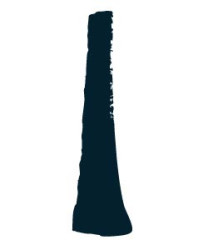Walter Dusenbery lives and works in Italy. This sculpture is named for the town in which he lives. It is also the name of the quarry from which the stone was mined. The stone is called travertine and it is very soft and easy to carve. With this sculpture, the artist used both smooth and rough pieces of stone. Dusenbery believes that by sculpting with natural materials (such as wood, clay, or in this case, stone) you can be closer to the natural environment.
The stone used to make this sculpture is very soft. How might the sculpture and its texture be different if it was made with very hard stone?
How do the rough pieces look compared to the smooth ones beside them? How would the sculpture be different if it had one uniform texture?
Why do you think the artist named this sculpture after the place from which the stone was mined? Why would this information be important to him?
In your house and yard find objects that have texture, such as the bark of a tree, concrete, or the tiles in your kitchen. Lay a piece of paper over them and rub the paper with a crayon or pencil. Notice the pattern or texture that is now on the paper. Once you have collected several textures on paper, use scissors to cut them into different shapes. Now glue them onto another sheet, making a scene or picture.
Sculpture —A work of art that has height, width, and depth
Texture —How the surface of something looks or feels (for example, rough or smooth)
Carve —To cut away from a surface
Quarry —A hole or pit from which stone is excavated
Travertine —White or light-colored calcareous rock deposited from mineral springs

